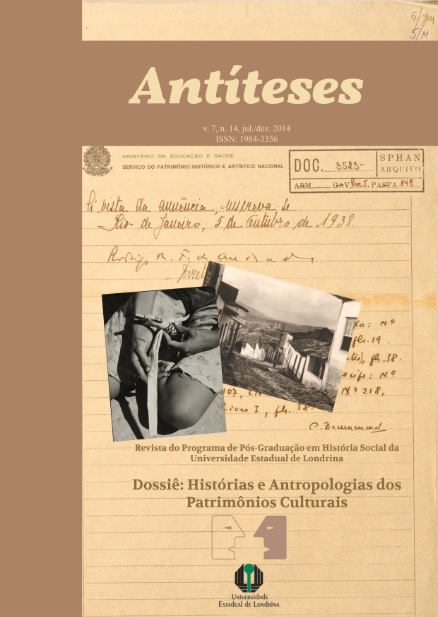From the small palace to the tenement: the use of hydraulic tiles in buildings of São Paulo city at the turn of the 20th century
DOI:
https://doi.org/10.5433/1984-3356.2014v7n14p348Keywords:
Hydraulic tiles, The small palace, The tenement, São PauloAbstract
This paper deals with hydraulic tiles (a type of flooring that results from the mixture of Portland cement with sand, water, marble and granite, and features colorful drawings of geometric or floral shapes) of some constructions built in the city of São Paulo at the turn of the 20th century - more specifically during the last decades of the 19th century and during the first decades of the 20th. We aim here to demonstrate how this building material, which was at first used on the floor of the richest houses of São Paulo city (such as some of the ancient small palaces), as a kind of symbol of status, would spread out little by little, being found at some other types of buildings, in some old workers' houses, and even in one of the poorest type of house of the city - the tenement, associating the different degrees of complexity of the hydraulic tile design to income level of the original owners - the more complex the design, the higher the price of each piece and therefore the richer the owner of the building. Also noteworthy is how this material produced by hand still valued by architects and other professionals today, due to the richness of its drawings, its colors and the diversity of possibilities of composition of its parts.Downloads
Download data is not yet available.
References
ALEMÃO, F. F. Manuscrito (1859). Anais da Biblioteca Nacional, Rio de Janeiro, v. 81, 1961.
AMERICANO, Jorge. São Paulo nesse tempo (1915-1935). São Paulo: Melhoramentos, 1962.
ARAGÃO, Solange de. Ensaio sobre a casa brasileira do século XIX. São Paulo: Edgard Blücher, 2011.
ARAGÃO, Solange de. Ensaio sobre o jardim. São Paulo: Global, 2008.
BECKER, A. W.; VUOLO, C. M. O mago dos ladrilhos hidráulicos (Depoimento). Revista Pós-São Paulo, v.16, n.25, p.27-32, jun. 2009.
BENCLOWICZ, Carla Milano. Prelúdio modernista: construindo a habitação operária em São Paulo. 1989. Dissertação (Mestrado em Arquitetura e Urbanismo) - Faculdade de Arquitetura e Urbanismo, USP, São Paulo, 1989.
BLAY, Eva. Eu não tenho onde morar: vilas operárias na cidade de São Paulo. São Paulo: Nobel, 1985.
CARPINTÉRO, Marisa Varanda Teixeira. Imagens do conforto: a casa operária nas primeiras décadas do século XX em São Paulo. In: BRESCIANI, Stella (Org.). Imagens da cidade. São Paulo: Marco Zero: FAPESP, 1993.
CORDEIRO, Simone Lucena (Org.). Os cortiços de Santa Ifigênia: sanitarismo e urbanização. São Paulo: Imprensa Oficial do Estado de São Paulo: Arquivo Público do Estado de São Paulo, 2010.
FREYRE, Gilberto. Ordem e progresso. 6.ed. São Paulo: Global, 2004.
FREYRE, Gilberto. Sobrados e mucambos. 16. ed. São Paulo: Global, 2006.
HOMEM, Maria Cecília Naclério. O palacete paulistano e outras formas urbanas de morar da elite cafeeira: 1867-1918. São Paulo: Martins Fontes, 1996.
LEMOS, Carlos. Os primeiros cortiços paulistanos. In: SAMPAIO, Maria Ruth Amaral de (Coord.). Habitação e cidade. São Paulo: FAUUSP: FAPESP, 1998. p.9-38.
MACHADO, Lúcio Gomes. Apresentação para a exposição: Se esta rua fosse minha. São Paulo: Museu da Casa Brasileira, 2005.
MARQUES, J. de S. Estudo do processo de produção de ladrilhos hidráulicos. Londrina: UEL, 2012.
MAWE, J. Viagens ao Interior do Brasil. São Paulo: Ed.Universidade de São Paulo, 1978. (Coleção Reconquista do Brasil, v.33).
PICCINI, Andréa. Cortiços na cidade: conceito e preconceito na reestruturação do centro urbano da São Paulo. 2. ed. São Paulo: Annablume, 2004.
REIS FILHO. Nestor Goulart. Quadro da arquitetura no Brasil. São Paulo: Perspectiva, 1970.
SAINT-HILAIRE, Auguste de. Viagem à província de São Paulo (1816-1822). Trad. Regina Régis Junqueira. Belo Horizonte: Itatiaia; São Paulo: Edusp, 1978.
SCHMIDT, Afonso. Aventuras de Indalécio. São Paulo: Clube do Livro, 1951.
SPIX, Johann Baptist Von; MARTIUS, Carl Friedrich Philipp Von. Viagem pelo Brasil (1817-1820). Trad. Lúcia Furquim Lahmeyer. São Paulo: Melhoramentos, 1938. Primeira tradução para o português, em comemoração ao seu centenário.
VAUTHIER, Louis Léger. Cartas a César Daly (1853). Arquitetura Civil I. São Paulo: FAU-USP, IPHAN, 1975. p.27-94.
AMERICANO, Jorge. São Paulo nesse tempo (1915-1935). São Paulo: Melhoramentos, 1962.
ARAGÃO, Solange de. Ensaio sobre a casa brasileira do século XIX. São Paulo: Edgard Blücher, 2011.
ARAGÃO, Solange de. Ensaio sobre o jardim. São Paulo: Global, 2008.
BECKER, A. W.; VUOLO, C. M. O mago dos ladrilhos hidráulicos (Depoimento). Revista Pós-São Paulo, v.16, n.25, p.27-32, jun. 2009.
BENCLOWICZ, Carla Milano. Prelúdio modernista: construindo a habitação operária em São Paulo. 1989. Dissertação (Mestrado em Arquitetura e Urbanismo) - Faculdade de Arquitetura e Urbanismo, USP, São Paulo, 1989.
BLAY, Eva. Eu não tenho onde morar: vilas operárias na cidade de São Paulo. São Paulo: Nobel, 1985.
CARPINTÉRO, Marisa Varanda Teixeira. Imagens do conforto: a casa operária nas primeiras décadas do século XX em São Paulo. In: BRESCIANI, Stella (Org.). Imagens da cidade. São Paulo: Marco Zero: FAPESP, 1993.
CORDEIRO, Simone Lucena (Org.). Os cortiços de Santa Ifigênia: sanitarismo e urbanização. São Paulo: Imprensa Oficial do Estado de São Paulo: Arquivo Público do Estado de São Paulo, 2010.
FREYRE, Gilberto. Ordem e progresso. 6.ed. São Paulo: Global, 2004.
FREYRE, Gilberto. Sobrados e mucambos. 16. ed. São Paulo: Global, 2006.
HOMEM, Maria Cecília Naclério. O palacete paulistano e outras formas urbanas de morar da elite cafeeira: 1867-1918. São Paulo: Martins Fontes, 1996.
LEMOS, Carlos. Os primeiros cortiços paulistanos. In: SAMPAIO, Maria Ruth Amaral de (Coord.). Habitação e cidade. São Paulo: FAUUSP: FAPESP, 1998. p.9-38.
MACHADO, Lúcio Gomes. Apresentação para a exposição: Se esta rua fosse minha. São Paulo: Museu da Casa Brasileira, 2005.
MARQUES, J. de S. Estudo do processo de produção de ladrilhos hidráulicos. Londrina: UEL, 2012.
MAWE, J. Viagens ao Interior do Brasil. São Paulo: Ed.Universidade de São Paulo, 1978. (Coleção Reconquista do Brasil, v.33).
PICCINI, Andréa. Cortiços na cidade: conceito e preconceito na reestruturação do centro urbano da São Paulo. 2. ed. São Paulo: Annablume, 2004.
REIS FILHO. Nestor Goulart. Quadro da arquitetura no Brasil. São Paulo: Perspectiva, 1970.
SAINT-HILAIRE, Auguste de. Viagem à província de São Paulo (1816-1822). Trad. Regina Régis Junqueira. Belo Horizonte: Itatiaia; São Paulo: Edusp, 1978.
SCHMIDT, Afonso. Aventuras de Indalécio. São Paulo: Clube do Livro, 1951.
SPIX, Johann Baptist Von; MARTIUS, Carl Friedrich Philipp Von. Viagem pelo Brasil (1817-1820). Trad. Lúcia Furquim Lahmeyer. São Paulo: Melhoramentos, 1938. Primeira tradução para o português, em comemoração ao seu centenário.
VAUTHIER, Louis Léger. Cartas a César Daly (1853). Arquitetura Civil I. São Paulo: FAU-USP, IPHAN, 1975. p.27-94.
Downloads
Published
2014-12-22
How to Cite
ARAGÃO, Solange de; SOUZA, Thais. From the small palace to the tenement: the use of hydraulic tiles in buildings of São Paulo city at the turn of the 20th century. Antíteses, [S. l.], v. 7, n. 14, p. 348–372, 2014. DOI: 10.5433/1984-3356.2014v7n14p348. Disponível em: https://ojs.uel.br/revistas/uel/index.php/antiteses/article/view/20065. Acesso em: 23 dec. 2025.
Issue
Section
Articles
License
Copyright (c) 2014 Antiteses

This work is licensed under a Creative Commons Attribution 4.0 International License.
The journal reserves the copyright on the contributions published, without material compensation for the author, and may make them available online in Open Access mode, through its own system or other databases; you can also make normative, orthographic and grammatical changes in the originals, in order to maintain the cultured standard of the language, with the final consent of the authors. The opinions expressed by the authors are their sole responsibility.










